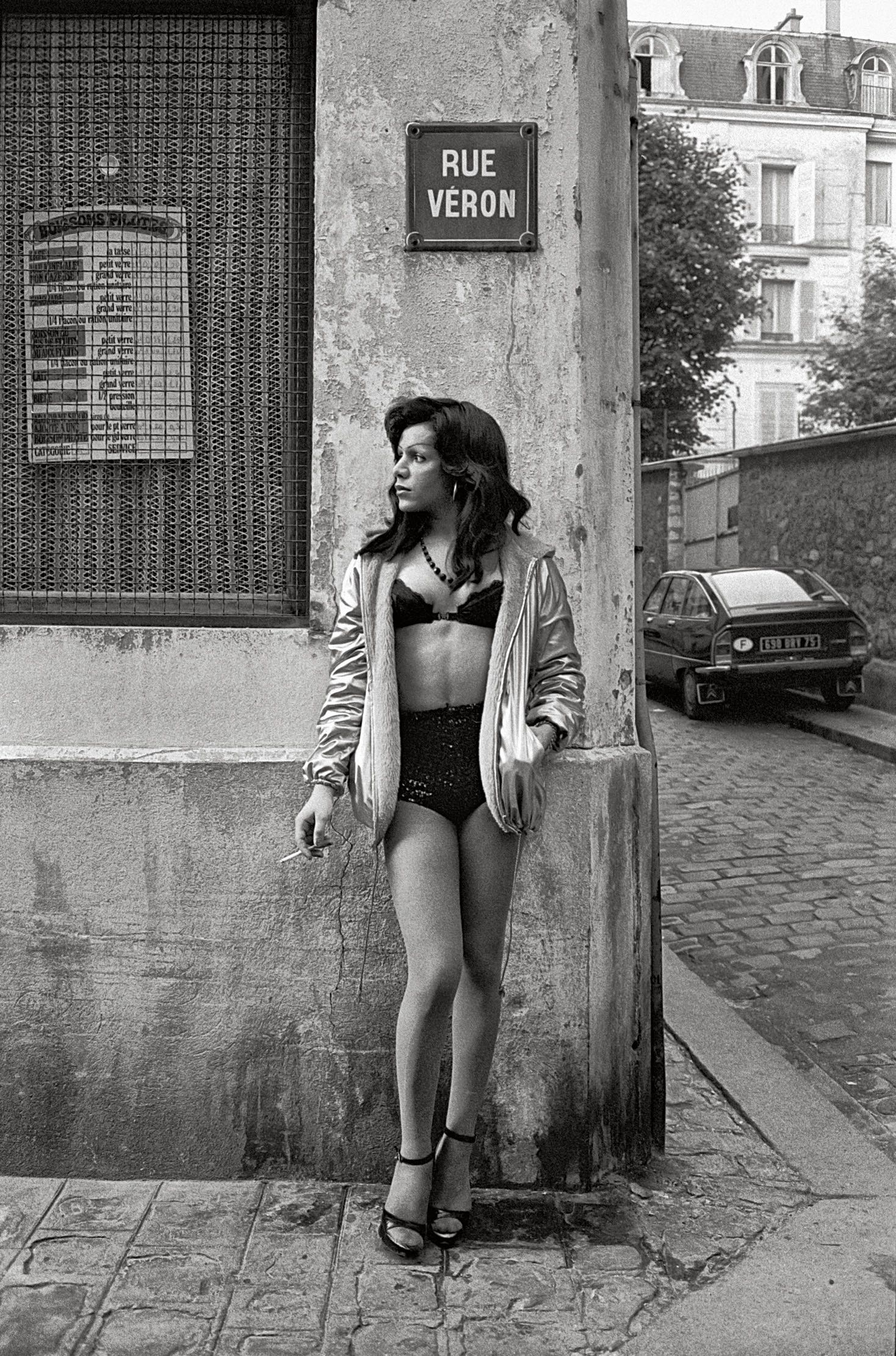Photos that capture the red lights of ’70s Paris
- Text by Ellie Howard
- Photography by Jane Evelyn Atwood

Pigalle is a place of discretion. By design, its network of streets allows for anonymity, but it’s also possible to lose yourself. Historically, the red light district was created to fence-in Parisian society’s less ‘civilised’ activities, yet within its parameters, those who escaped traditional gender roles found a type of caged freedom. For the heavily stigmatised trans community of the ’70s, there was little else to turn.
Jane Evelyn Atwood devoted her early career to capturing those who fall into this category. Often, her subjects were groups discarded by society, who because of their vulnerable position were unable to protect themselves against injustices. Her latest book, Pigalle People (1978 – 79), published 40 years in retrospect, followed the lives of the trans-sex-workers as they navigated the crepuscular world of Pigalle, a dense maze of erotic cabarets, go-go bars and neon-lit strip joints.
Pigalle People introduces a number of colourful characters who brawl with troublemakers, shoot-up, solicit much shorter clients, and link arms walking down cobbled streets, smiling as multiple kisses are bestowed.

Atwood was introduced to this tight-knit circle by Blondine, a sex-worker with whom she was close. “I never thought I would photograph Pigalle, but I had been given that entrée,” she remembers. “It’s a paradox that photography allows you to know people better… I need to know how they do things, how they get up in the morning.”
While Atwood’s documentation couldn’t ignore the unvarnished painful reality of the women’s lives, the photographs depict their defiance and resistance. Dreams and personal histories are all made visible. An approach typical of the photographer, whose reverence and consideration of her subjects, becomes palpable throughout each turn of the page.

Pigalle has always invited tourism. The endless gawking and documentation would often be a source of discomfort for the women soliciting. Although with time, Atwood proved herself trustworthy. “You can’t just barge in and start taking pictures,” she recalls. “It’s not my world, I will always be just a visitor. As a visitor, I had to respect and behave a certain way.”
When AIDS hit Pigalle later, many of those Atwood photographed lost their lives; if not blotted out before, due to drugs or violence.
“It’s really a witnessing,” she explains. “I loved them and I felt privileged to have been allowed in their world. By publishing the book, I’m giving it to other people and saying this is what I lived, this is what it was like. People can draw their own conclusions.”


Pigalle People is available now.
Follow Ellie Howard on Twitter.
Enjoyed this article? Like Huck on Facebook or follow us on Twitter.
You might like

“Humanity’s big threat is our disconnect from nature”: Craig Richards and Chris Levine in conversation
Lighting up — With Houghton Festival collaborating with artist Chris Levine in its most recent edition, we sat down with the light artist and the festival’s creative director Craig Richards to chat about their new installations, and the role of art and music in tumultuous times.
Written by: Isaac Muk

Three heart wrenching poems from Gaza
Writings that narrate — With Gaza’s population facing starvation, we are handing over our website to Yahya Alhamarna, a displaced poet and student in Gaza, who shares some of his recent poetry, and explains why writing is so important to him.
Written by: Yahya Alhamarna

Throwback portraits of the UK’s first punks
Punks 1978-1980 — While working as a photographer in the army, Wayne “Spike” Large would moonlight as a punk on the weekends. His new photobook revisits the characters that he captured from the genre’s heyday.
Written by: Miss Rosen

Meet Lady Pink, the ‘First Lady’ of graffiti
Miss Subway NYC — As a leading writer and artist in a man’s world, Sandra Fabara has long been a trailblazer for girls in underground art. Now, her new show touches on her legacy, while looking to the future.
Written by: Isaac Muk

As Grindr scams in India rise, its LGBTQ+ community fights back
Red flags — Through mobilising the threat of outing queer folk, scammers are using dating apps to find targets for extortion, violence and blackmail. Mansi Rathee and Amir Bin Rafi spoke to people who have been affected, and reported on the community’s work to support victims and raise awareness.
Written by: Mansi Rathee

Will internet age verification actually work?
VPN Summer — With the Online Safety Act coming into force over the weekend, the UK woke up to find pornography, but also any content deemed “harmful” hidden behind an ID wall. But young people are far too tech savvy to be deterred, explains newsletter columnist Emma Garland, who also warns of the dangers of mass data harvesting.
Written by: Emma Garland

